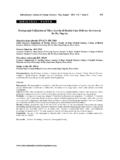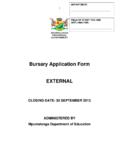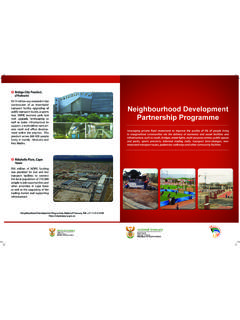Transcription of JOSIAH MACHARIA Pwani Feeds Manufacturers Limited
1 110 GLOBAL GROWING CASEBOOKJOSIAH MACHARIAP wani Feeds Manufacturers LimitedEXECUTIVE SUMMARYThis case study describes the success story of Pwani Feeds , a leading animal feed manufacturing company in Kenya. Shem Mwaura, the CEO of Pwani Feeds , is a Kenyan entrepreneur. Before establishing Pwani Feeds he worked in a mill and launched grocery and cereal shops with his 1995, Mr. Mwaura decided to open his own business trading eggs and feed in Thika, Central Kenya. The original business model was based on two ideas: first, collecting eggs from decentralised local farmers and selling them on the market in Mombasa while simultaneously supplying these farmers with Feeds they couldn t otherwise obtain.
2 After three years, Mr. Mwaura extended his business by producing and selling his own animal and poultry Feeds . A factory was set up in Mombasa and feed production experts were recruited to develop high performance Feeds established egg collection centres in the Coastal Region and developed a unique Delivery Route Business Model for the Central Province. Farmers were guaranteed the same price offered by other middlemen, but what set Pwani apart was the provision of free additional services. The farmers bene-fitted mostly from the company s direct delivery of Feeds , which saved them time and transport costs.
3 Advisory services (record keeping, animal health care, and a demonstration farm) were also provided for free. In 2006, the business model was expanded to the practice of fattening bulls that were about to be socio-economic value of this case lies in the fact that the Pwani model created 300 jobs in two factories, thereby alleviating poverty as well as improving gender equality 70 percent of the Kenyan poultry farmers are studies : AGRICULTURAL INNOVATION 111 INTRODUCTIONMr. Shem Mwaura, the CEO of Pwani Feeds , had just settled down in his new offices in Thika, a town in the geographic centre of Kenya.
4 The decision to relocate the head office from the coastal town of Mombasa to Thika was rooted in Mr. Mwaura s belief that with the company s infrastructure already well in place, the time was ripe to roll out more branches throughout the country. To do this, scalable systems and structures had to be established deeper in the hinterlands of Kenya to ensure a smoothly functioning organisation and the creation of an efficient logistical transportation structure. Up to this time, Pwani Feeds had been manufacturing animal Feeds , mainly dairy and poultry Feeds , with the majority of the firm s output serving the coastal and central regions of Kenya.
5 AGRICULTURE & Feeds MANUFACTURING IN KENYA Agriculture is the lifeblood for about 80 percent of the Kenyan population. It provides employment to over 70 percent of the labour force and contributes 53 percent of the country s Gross Domestic Product (GDP) 26 percent directly and 27 percent indirectly (through linkages to processing and services). It also THIKANAIROBIMOMBASALOCATION OF THIK A AND MOMBASAKENYA112 GLOBAL GROWING CASEBOOK contributes 45 percent to the public coffer through taxation. Most of the agricul-tural production in Kenya is comprised of mixed farming (growing of crops and rearing of livestock).
6 Livestock farming consists primarily of dairy and poultry farming (with pig farming occurring to a lesser extent).DAIRY FARMING IN KENYAK enya has one of the largest dairy industries in sub-Sahara Africa (EPZ 2009). The industry developed over a period of 90 years with several distinct evolution-ary stages. The first 60 years were dominated by large-scale farmers, but the last 30 years have seen smallholder farms increasingly dominating the sector with smallholders now accounting for over 80 percent of total milk production. The dairy trade has evolved through three distinct market periods: From the period up to 1969 it operated as an open market with various inde-pendent dairies being active market players; Between 1969 and 1992, primarily due to the rationalisation of the dairy industry by the Government, a monopolistic market situation existed; and From 1992 the market has operated under a Government-backed liberalisa-tion to 1992, the dairy industry in Kenya was under government control.
7 Policy guidelines and prices were set by the government and these determined which players could survive in the industry. The body responsible for regulating the dairy industry was the Kenya Dairy Board. During its history, Kenya has been largely self sufficient in milk production. Production stood at billion litres per annum. Although this amount met domestic consumption needs, much more demand existed within the export market. Kenya had an estimated million dairy cattle and as stated, the Kenyan dairy industry was based mostly on smallholder milk production. About 600,000 smallholders produced 70 percent of the country s marketed milk.
8 Approximately 56 percent of this milk was sold raw in the unregulated informal market, leading to public concerns about hygiene and studies : AGRICULTURAL INNOVATION 113 POULTRY FARMING IN KENYAP oultry accounts for about percent of total agricultural GDP. According to the 2007 Ministry of Livestock Development report (Mbugua 2010), the following were the estimated poultry product outputs: 21,000 tonnes of poultry meat, valued at billion Kenyan shillings (KSh) ( million Euro, as of 2011); billion eggs (53 percent from hybrids and 47 percent from indigenous stock) valued at KSh billion (92,7 million Euro).
9 Achieving optimal genetic potential within the chicken population depended on three main factors: The environment in which the chickens are raised should be managed to pro-vide birds with proper ventilation, good air quality, comfortable temperatures, and adequate space; Developing chicks must be provided with a dietary regimen that supplies nutrients in an appropriate blend. Poultry get their nutrient requirements through the compounding of suitable feed ingredients plus proper manage-ment of the ratio in which feed and water are supplied (for a detailed egg production process see page 121); Effective sanitation and disease prevention programmes are the last crucial component.
10 Farm procedures must be able to prevent disease incursion, and if prevention fails procedures must detect illness early and accurately diagnose ill Feeds MANUFACTURING IN KENYAMost animal feed Manufacturers in Kenya practiced what was known as mixed feed production (Karuri 2010). This means that they produced Feeds for dairy cat-tle, poultry, and pigs on the same site. The first firm to produce mixed Feeds was established in Kenya in the 1950s. Since then, the feed industry has grown not only in terms of the volume of feed produced but also by putting in place policies to ensure quality feed production.








